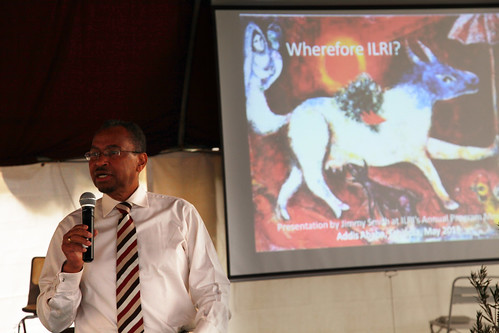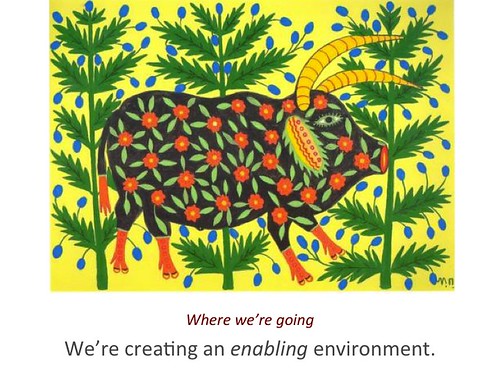
Jimmy Smith, director general of ILRI, speaks about the past, present and future of ILRI at ILRI’s Annual Program Meeting 2013, in Addis Ababa, Ethiopia (photo credit: ILRI/Zerihun Sewunet).
Jimmy Smith, director general of the International Livestock Research Institute (ILRI), opened ILRI’s Annual Program Meeting today (15 May 2013), which is being held on ILRI’s campus in Addis Ababa, Ethiopia, with some 250 participants, with a quick review (especially for ILRI’s many new staff) of where the institute has come from, where it is now and where it’s going.
Here’s some of what he said.
Ever since the food crisis in 2007, issues around food security have dominated global discussions. At the same time, we began to see that our ability to increase food production using conventional methods is insufficient to feed the growing world population.
So it’s a great time for science. We have the attention of policymakers at the highest levels, who are depending on us to find ways to feed the world, to lift the world’s vast army of small-scale rural food producers out of poverty, and to protect our environments and their critical natural resources that are the foundation of agriculture and human well-being.
We have new opportunities to work across the developing world with our partners, including nongovernmental organizations and the broader development community, to translate this research into big development benefits.
It is this prospect that is buoying me up today.
Now, about where we’re going.
Where ILRI is going
From pathways out of poverty to better lives through livestock.
Smallholders can contribute to global food and nutritional security, and to broader development goals, and do so in ways that are sustainable.
From reactive responses to proactive management of livestock ‘bads’.
We’re not getting rid of cars but rather making them more efficient with new parts like this turbocharger for sale. Similarly, we’re not going to get rid of farm animals but we can and must make livestock production systems more efficient.
From regional presence to regional programs.
We will have a larger presence in the regions so that we can engage our regional partners in more meaningful ways.
From action research to development in action.
The new CGIAR requires that our work show impact—and we have to form the partnerships that will allow us to do that.
We’re removing our ‘candle from under the bushel’ so that we have influence.
Not a lot of people other than those who read agricultural papers in science journals know about ILRI. We must be able to speak to all, to be relevant to many different audiences. We must shine our candle everywhere livestock matters are important matters for the poor.
We’re restoring our biosciences lustre.
As funding for long-term research dried up in the 1980s and 90s, investments in agriculture, especially the more long-term agricultural research, declined precipitously. So we lost much of our ability to conduct upstream biological science in the critical fields of animal feeds, nutrition and health. We see an opportunity to regain ground and do advanced bioscience that complements our integrated animal science so that we deliver fully on our mandate.
We’re building a business culture.
We must deliver our products to agreed specifications and quality, within budget and on time.
We’re creating an enabling environment.
Your directors are not your masters but your servants; it’s our job to provide you with an enabling environment so you can do your jobs.
Last words
We must make ILRI the world’s renowned research for development institution.
To make a difference, we’ll have to be the difference, the preferred place people come to for pro-poor livestock science, products, information, technologies, policies . . . .
We must make ILRI the place to be and work.
We want every one of you to be profoundly satisfied with your work here.
We must work for the poor.
That’s what we signed up to. Not because it’s our job. Because it’s our mission.
View the whole slide presentation by Jimmy Smith.
More on ILRI’s strategy 2013-2022


